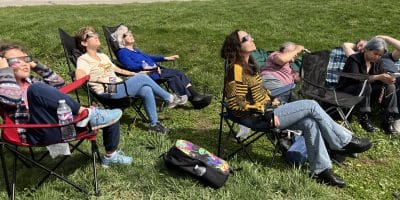
Story and photos by Bruce Stambaugh, contributor
What goes up must come down.
That old axiom recently proved to be true for six Eastern Mennonite University engineering students. Only the results weren’t quite what they expected.
On the morning of Nov. 25, after weeks of planning, juniors Karissa Sauder and Douglas Nester and four classmates sent a latex weather balloon high into the morning’s clear blue sky from atop the hill near the Discipleship Center. It carried a payload designed to communicate back to them via radio signal. According to their calculations, the helium-filled balloon would burst once it reached an altitude of 125,000 feet, then parachute back to earth and land somewhere in the vicinity of Parkersburg, W.Va., near the Ohio-West Virginia line.
And indeed, Nester said, the balloon went up and drifted roughly the anticipated distance before bursting – although it traveled almost in the exact opposite direction. After three and a half hours in the air, the payload landed in a cornfield on Maryland’s Eastern Shore, where it was recovered by the Maryland State Police.
Nester said they first tried contacting the landowners where the payload came down. When that was unsuccessful, they called the state police were contacted, who made the recovery before an individual coming to Harrisonburg brought the payload to EMU.
“We believe that somehow we may have read the wind data from NOAA wrong and missed some sort of negative in the simulation,” Sauder said.
Nester reported another significant problem with the payload.
“Communication was lost with the balloon for much of its journey,” he said. “We speculate the cause was the low temperatures that are present at high altitudes.”
Nester said they lost the signal when the balloon had risen about 1,600 feet above the launch site.
The payload resumed sending latitude, longitude, and altitude coordinates as it descended, however, allowing the team to know where it landed. They were also able to retrieve the various temperatures, humidity, and ozone readings that the payload encountered.

Still, the experience was a valuable one for the engineering students, who had to design their balloon and payload to withstand the environmental conditions and meet the requirements of the Federal Aviation Administration.
“The payload had to be light-weight and durable,” Nester explained to a crowd of about 75 people before the balloon’s launch. Many of the spectators were elementary students from nearby Eastern Mennonite School.
For the balloon’s payload, students used a Styrofoam box to hold a small Raspberry Pi computer and a long-range (LoRa) battery-powered radio that used a low power wireless platform to transmit GPS readings to a computer on campus. It did so using the 24 satellites of the Navigation Satellite Time and Ranging (NAVSTAR) system. The balloon also carried a tiny camera to take photos of its journey, although the radio was not designed to transmit those during flight.
“The camera took almost 1,200 photos, the bulk of which were photos of the ground and the cornfield where it ended up,” Nester said.
Sauder said the group wrote a program that estimated the altitude, distance, direction, and time the flight of their balloon would take from launch to touchdown. All in all, it was a launch long in the making – last February, Sauder and Nester presented the project at Hampden-Sydney College in Hampden Sydney, Virginia.
Journalism is changing, and that’s why The Citizen is here. We’re independent. We’re local. We pay our contributors, and the money you give goes directly to the reporting. No overhead. No printing costs. Just facts, stories and context. Thanks for your support.













